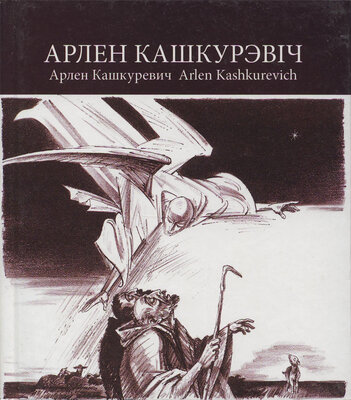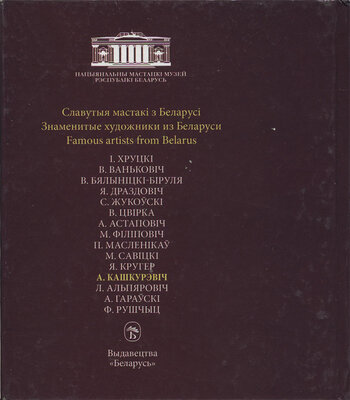Арлен Кашкурэвіч
Выдавец: Беларусь
Памер: 83с.
Мінск 2014
For many years Arlen Kashkurevich remained faithful to his creative programme philosophical musing on eternal problems of being, reflection on man and time, spiritual search for truth. But the art of Kashkurevich is not a declaration or discussion. It has ever contained some definite or categorical answer, on the contrary, it is a complex polyphonic phenomenon that demands hard work from intellect and feelings, empathy, associative perception of aesthetic information suggested by the artist and always addressed to the spiritual world of the audience.
In a large cycle of drawings Concerto Grosso (Big Concert) created in 2003—2006 the artist embodied metaphorically a tragic collision between a musician and his instrument, a creator and his art, brave confrontation of an artist to the impossibility of reaching ideal. Various spiritual conditions that accompany creative process, such as deep thoughtfulness, melancholy, sorrow, inspiration, catharsis and wrath, are embodied in the drawings of the series. It is no coincidence that in musical themes of the sheets prevail terms «con affizione» (mournfully, sadly), «desolato» (sorrowfully, vainly) together with «selvaggio» (courageously), «sdegnosamento con resoluto» (angrily and resolutely).
Common emotional atmosphere unites works of the series This Sweet City Life... (1987—2004), which is full of thoughts about the millennium problem: the problem of individuality in the society, human existence in a complicated modern world. The main theme of the cycle is an image of a person who is lost in a metropolis, the one who is alienated from the city, society and himself. Existential accents are clearly seen in a dramatic contrast of etchings (Person in an Elevator, 1988; Crossroads, 1993) and in a strict calm of the lines of pen drawings (Leaf Fall, 1994; Person in the Rain, 2004; Old Musician and His Dog, 2001; Expectation, 2002). Esentially, the hero of the Kashkurevich’s works is a tragic person. Minor intonations and sometimes tragic notes pierce all works of the master in which dominate various hues of sadness, bitter thoughts, sorrow, despair, anger and, at the same time, of commiseration and sympathy. Here moral and aesthetic credo of the artist found its full embodiment. Origins of this credo are in the best traditions of European humanism and Slavic culture. This is a different side of humanism devoid of any illusions or complacence.
Recreation of scenes and images from Gospel and the Old Testament became of no little interest to the artist in the 1990—2000s. A large series of drawings in Indian ink Sublime Song of Solomon (1994—1996) after The Song of Songs is full of flavour of the Middle East (sheets Dance with a Tambourine, Dance with Swords, Hunt of the Pharaoh). Distinctively and in not a traditional way
the artist interpreted evangelic stories Temptation of Christ in the Desert, Angel and Shepherds and The Return of the Prodigal Son (1992). In these works the artist attempted modern interpretation of the classics through the prism of the solution of complex moral and ethical issues of our civilization.
Natural desire to communicate constantly with his audience was implemented in frequent participation of Kashkurevich in all republican, all-union and foreign exhibitions. It is impossible to imagine at least one of the exhibitions without works of this prominent master. His personal exhibitions were held in Yugoslavia (1965), Japan (1970), Moscow (1975), Germany (1977), Lithuania (1981), Estonia (1983), Poland (1988), Iceland (1989), Taiwan (1995), France (1996) and also in the USA, Syria, Algeria, Mongolia, Finland, China, etc.
In 1991, Arlen Kashkurevich was awarded the title of the Peoples Artist of Belarus.
The creative work of the Peoples Artist of Belarus, the laureate of the BSSR State Prize, professor Arlen Mikhailavich Kashkurevich is one of the brightest phenomena of contemporary Belarusian art.
His name is widely known among connoisseurs of visual arts in our country and abroad. Leading art museums consider having works of Arlen Kashkurevich in their funds as a great honour. His works are kept in the collection of the National Art Museum of the Republic of Belarus, in the funds of the Artists’ Union of Belarus, in the Museum of Contemporary Belarusian Art (Minsk), the National Museum of Belarusian History and Art, the State Tretiakov Gallery (Moscow), the Directorate of Exhibitions of the Artists’ Union of the Russian Federation (Moscow), the Museum of Contemporary Art (Skopje, Macedonia), the Picture Gallery of Bender (Moldova), the Goethe and Schiller Museum (Weimar, Germany), in the museums of Polotsk, Grodno, Kiev, and private collections in Belarus, Iceland, Poland, Germany, the USA, etc.
The Kashkurevich family is a true conglomerate of talents. The sons Igar and Fiodar fruitfully work in various spheres of visual arts. They are famous Belarusian artists, whose works are kept in the collections of the National Art Museum of the Republic of Belarus, the Directorate of Art Exhibitions of the
Artists’ Union of Belarus and also in many private Belarusian and foreign collections. The wife of the artist Ludmila Alyaksandrauna does not stay away from the artistic creativity. Her watercolours and works in the field of decorative and applied arts tell about a genuinely talented person.
For our contemporaries the personality of Arlen Kashkurevich, the intellectual artist, is inseparable from his art which always evokes recognition and genuine interest in the society due to its actuality, difficulty and dramatic character.
Kanstantsin Barabanau
Гурзуф. Лесвіца. 1963
Гурзуф. Лестница. 1963
Gurzuf. Staircase. 1963
Ісландыя на вуліцы. 1959
Исландия на улице. 1959 Iceland on the street. 1959
Вечарынка. 1959
Вечеринка. 1959
Party. 1959
Магілальва. 1962
Могила льва. 1962 Lion’s Tomb. 1962
Бандароўна. 1962
Бондаровна. 1962
Bandarouna. 1962
Курган. 1962
Курган. 1962
Barrow. 1962
Магіла льва. 1962
Могила льва. 1962
Lions Tomb. 1962
Натхненне. 1966—1967
Вдохновение. 1966—1967
Inspiration. 1966—1967
Шкловыдзімальнік. 1966—1967
Стеклодув. 1966—1967
Glass Blower. 1966—1967
Партызанскія маці. 1970
Партизанские матери. 1970
Partisan Mothers. 1970
Смага. 1969
Жажда. 1969
Thirst. 1969
Ілюстрацыя да паэмы Янкі Купалы«Яна і я». 1969 Иллюстрация к поэме Янки Купали «Она и я». 1969 Illustrations to the poem She and I by Yanka Kupala. 1969
Ілюстрацыя да паэмы Янкі Купалы «Адвечная песня». 1969
Иллюстрация к поэме Янки Купалы «Извечная песня». 1969
Illustrations to the poem Eternal Song by Yanka Kupala. 1969
Полымя. 1978
Пламя. 1978
Fire. 1978
Ураджай вайны. 1978
Урожай войны. 1978
Harvest of War. 1978
Ілюстрацыя да паэмы М. Гусоўскага «Песня пра зубра». 1980
Иллюстрация к поэме Н. Гусовского «Песнь о зубре». 1980
Illustration to the poem The Song about Bison by M. Gusowski. 1980
Ілюстрацыя да паэмы М. Гусоўскага «Песня пра зубра». 1980
Иллюстрация к поэме Н. Гусовского «Песнь о зубре». 1980
Illustration to the poem The Song about Bison by M. Gusowski. 1980
Ілюстрацыя да паэмы М. Гусоўскага «Песня пра зубра». 1980
Иллюстрация к поэме Н. Гусовского «Песнь о зубре». 1980
Illustration to the poem The Song about Bison by M. Gusowski. 1980
Ілюстрацыя да паэмы М. Гусоўскага «Песня пра зубра». 1980
Иллюстрация к поэме Н. Гусовского «Песнь о зубре». 1980
Illustration to the poem The Song about Bison by M. Gusowski. 1980
Сад Марты. 1981
Сад Марты. 1981
Marthas Garden. 1981
Прасвятленне. 1981
Прозрение. 1981
Enlightment. 1981
Кабінет Фауста. 1981
Кабинет Фауста. 1981
The Study of Faust. 1981
Ведзьмы. 1981
Ведьмы. 1981
Witches. 1981
Ашуканцы. 1984
Обманщики. 1984
Deceivers. 1984
Кароль голы! 1984
Король голый! 1984 The King is Naked! 1984
Ілюстрацыя да аповесці А. Адамовіча «Карнікі». Супервокладка. 1982
Иллюстрация к повести А. Адамовича «Каратели». Суперобложка. 1982
Illustration to the novel Chasterners by A. Adamovich. Book cover. 1982
Ілюстрацыя да аповесці A. Адамовіча «Карнікі». 1982
Иллюстрация к повести А. Адамовича «Каратели». 1982
Illustration to the novel Chasterners by A. Adamovich. 1982
Ілюстрацыя да аповесці А. Адамовіча «Карнікі». 1982
Иллюстрация к повести А. Адамовича «Каратели». 1982
Illustration to the novel Chasterners by A. Adamovich. 1982
Ілюстрацыя да аповесці A. Адамовіча «Карнікі». 1982
Иллюстрация к повести А. Адамовича «Каратели». 1982
Illustration to the novel Chasterners by A. Adamovich. 1982
Раз’езд. 1986
Разъезд. 1986
A Crossing Loop. 1986
Манкурт. 1986
Манкурт. 1986
Mankurt. 1986
Утаймаванне Каранара. 1986
Укрощение Каранара. 1986 The taming of Karanar. 1986
Ракетадром. 1986
Ракетодром. 1986
Rocketdrome. 1986
Прага. 1993
Прага. 1993
Prague. 1993
Паляванне ў Вялікім Княстве Літоўскім. 1986
Охота в Великом Княжестве Литовском. 1986
Hunt in the Grand Duchy of Lithuania. 1986
Чалавек у ліфце. 1988
Человек в лифте. 1988
Person in an Elevator. 1988
Анёл і пастухі. 1992
Ангел и пастухи. 1992
Angel and Shepherds. 1992
Валькірыя. 1993
Валькирия. 1993
Valkirye. 1993
Плач Гудрун. 1993
Плач Гудрун. 1993
Weeping of Gudrun. 1993
Чалавек пад дажджом. 2004
Человек под дождем. 2004
Person in the Rain. 2004
Стары музыкант і яго сабака. 2001
Старый музыкант и его собака. 2001
Old Musician and His Dog. 2001
«Strenatomento selvaggio». 2004
«Strenatomento selvaggio». 2004
«Strenatomento selvaggio». 2004
«Sdegnosamento con resoluto». 2006
«Sdegnosamento con resoluto». 2006
«Sdegnosamento con resoluto». 2006
«Con affizione». 2006
«Con affizione». 2006
«Con affizione». 2006
«Stinguendo con silenzio». 2003
«Stinguendo con silenzio». 2003
«Stinguendo con silenzio». 2003
Спіс ілюстрацый Старонка Список иллюстраций СтРан^ List of illustrations
29 Гурзуф. Лесвіца. 1963. Папера, гравюра на кардоне.
Гурзуф. Лестница. 1963. Бумага, гравюра на картоне.
Gurzuf. Staircase. 1963. Engraving on cardboard, paper.
30 Ісландыя на вуліцы. 1959. Ілюстрацыя да рамана X. Лакснеса «Атамная станция». Папера, каляровая літаграфія.
 КНІГІ ОНЛАЙН
КНІГІ ОНЛАЙН


